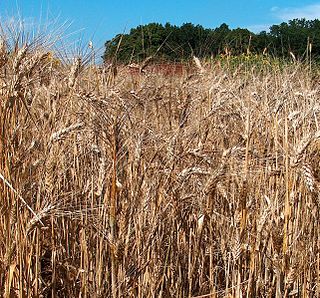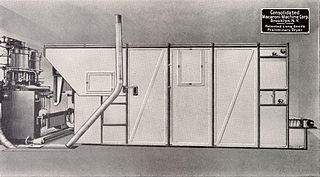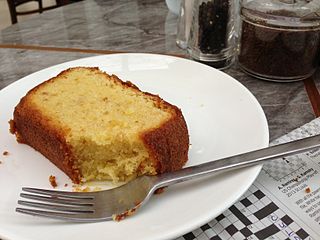Semolina is the middlings of durum wheat.
Semolina may also refer to:
- Semolina (horse), a racehorse
- Semolina (moth), a genus of moth
- Semolina pudding, or semolina porridge, made from semolina
Semolina is the middlings of durum wheat.
Semolina may also refer to:

Couscous is a North African dish of small steamed granules of rolled durum wheat semolina that is traditionally served with a stew spooned on top. Pearl millet, sorghum, Bulgur and other cereals can be cooked in a similar way in other regions and the resulting dishes are also sometimes called couscous.

Pasta is a type of food typically made from an unleavened dough of wheat flour mixed with water or eggs, and formed into sheets or other shapes, then cooked by boiling or baking. Rice flour, or legumes such as beans or lentils, are sometimes used in place of wheat flour to yield a different taste and texture, or as a gluten-free alternative. Pasta is a staple food of Italian cuisine.

Halva refers to various local confection recipes in West Asia and its vicinity. The name is used for referring to a huge variety of confections, with the most geographically common variety based on toasted semolina.

Durum wheat, also called pasta wheat or macaroni wheat, is a tetraploid species of wheat. It is the second most cultivated species of wheat after common wheat, although it represents only 5% to 8% of global wheat production. It was developed by artificial selection of the domesticated emmer wheat strains formerly grown in Central Europe and the Near East around 7000 BC, which developed a naked, free-threshing form. Like emmer, durum wheat is awned. It is the predominant wheat that grows in the Middle East.

Semolina is the coarse, purified wheat middlings of durum wheat mainly used in making couscous, pasta, and sweet puddings. The term semolina is also used to designate coarse middlings from other varieties of wheat, and sometimes other grains as well.

Upma, uppumavu or uppittu is a dish originating from the Indian subcontinent, most common in Kerala, Andhra Pradesh, Tamil Nadu,Karnataka, Maharashtrian, Gujarat, Odia and Sri Lankan Tamil breakfast, cooked as a thick porridge from dry-roasted semolina or coarse rice flour. Various seasonings and/ vegetables are often added during the cooking, depending on individual preferences. Today it is popular in most parts of India and is prepared in various ways.
Sima or SIMA may refer to:
Lapsi may refer to:

Galaktoboureko is a Greek, Turkish, and Syrian dessert of semolina custard baked in filo. Turkish Laz böreği is made with a type of pudding called muhallebi instead of semolina custard. It is popular in Rize and Artvin provinces in the Black Sea Region, home of many Laz people.

Bougatsa is a Greek breakfast pastry consisting of either semolina, custard, cheese, or minced meat filling between layers of phyllo.
Rava may refer to:
The Cosmopterigidae are a family of insects in the order Lepidoptera. These are small moths with narrow wings whose tiny larvae feed internally on the leaves, seeds and stems of their host plants. About 1500 species are described. The taxonomic family is most diverse in the Australian and Pacific region with about 780 species.
Kesari may refer to:
Semolina is a genus of moth in the family Cosmopterigidae. It contains only one species, Semolina leucotricha, which is found on Rapa Iti.

Semolina pudding or semolina porridge is a porridge-type pudding made from semolina, which is cooked with milk,or a mixture of milk and water, or just water. It is often served with sugar, cocoa powder, cinnamon, raisins, fruit, or syrup. A similar consistency to rice pudding can also be made by using more semolina and by baking, rather than boiling.

Pasta processing is the process in which wheat semolina or flour is mixed with water and the dough is extruded to a specific shape, dried and packaged.
Harcha is a semolina pancake native to the Middle Atlas in Morocco, and also found in Algeria.
Semolina was a British Thoroughbred racehorse and broodmare. Bred and owned by the 6th Duke of Portland, she was one of the best two-year-olds in England in 1889 when she won thirteen times from fifteen races. In the following spring she recorded her biggest success when she won the 1000 Guineas. She went on to run fourth in the Oaks Stakes and third in the Coronation Stakes, but never won again and was retired from racing at the end of the year. She had modest success as a dam of winners.
Love cake is a traditional semolina cake served in Sri Lanka on special occasions. They are often baked for cultural celebrations such as Christmas, birthdays and weddings, served wrapped in gold paper for guests to eat or take home.

Sugee cake is a cake made of semolina and almonds, creamed butter, eggs, and brandy, and optionally covered in marzipan and royal icing. The cake is typically baked during festive occasions and holidays like Christmas, by members of the Eurasian community in Malaysia and Singapore. The word sugee has its origins in Hindustani word for 'semolina'.